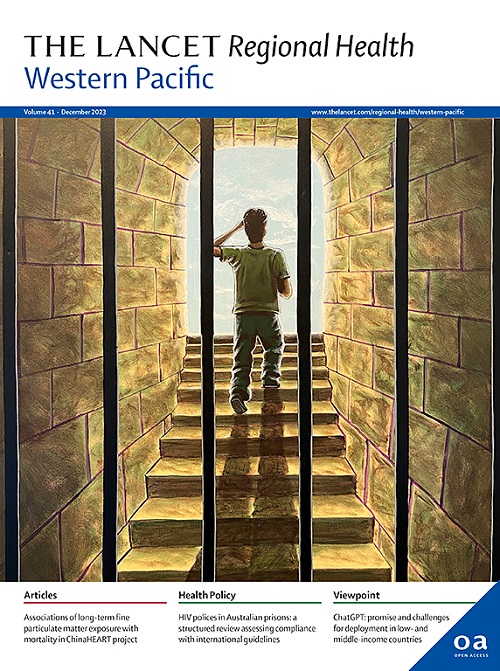Policies, resource allocation, and interventions for child and adolescent mental health in low- and middle-income countries in the Western Pacific Region: a scoping review
IF 8.1
1区 医学
Q1 HEALTH CARE SCIENCES & SERVICES
引用次数: 0
Abstract
Child and adolescent mental health (CAMH) has become an increasingly important public health issue worldwide and particularly in low- and middle-income countries (LMICs) in the Western Pacific Region (WPR), where access to quality mental health care remains limited. The existing evidence on CAMH in the region is fragmented and insufficient for guiding further development and improvements in CAMH services. Against this background, we conducted a scoping review to provide the most recent evidence of the resources (legal, financial, human, infrastructural) allocated to CAMH and the effectiveness of CAMH interventions in the 15 LMICs of the region, consisting of Cambodia, China, Fiji, Kiribati, Laos, Malaysia, the Marshall Islands, Mongolia, Papua New Guinea, the Philippines, the Solomon Islands, Tonga, Tuvalu, Vanuatu, and Viet Nam. Data were gathered from peer-reviewed publications and grey literature in both English and local language published since 2016, yielding a total of 16,869 publications in the initial search, including 15,708 peer-reviewed studies and 1161 grey literature publications, of which 260 English publications (118 peer-reviewed and 142 grey literature) and 384 local languages publications (124 peer-reviewed and 260 grey literature publications) were included in the review. China had the most included articles (53.7%), whereas the Pacific Island Countries (PICs), aside from Papua New Guinea, had the least. Legislation and policies on CAMH are underdeveloped in most PICs. Information on CAMH spending was available only in China, where 0.04% of total health spending was allocated to curative care for adolescent mental health. Countries with available data spent 1% or less of their total health spending on mental health overall (including CAMH), with CAMH beds ranging from 1.83% to 4.19% of total mental health beds and CAMH psychiatrists ranging from 0 to 34.2 per 100,000. Service utilization was low: children and adolescents made up 1.5%–5.4% of all mental health admissions. Effectiveness studies were found in only four countries: China, Malaysia, the Philippines, and Viet Nam. The review highlights significant knowledge gaps and challenges in CAMH resources in the WPR's LMICs, underscoring the need for stronger political commitment, financial investment, multisectoral collaboration, service delivery capacity, and research efforts. Given the predominance of evidence from China compared to other LMICs, this paper focuses on the latter, with China discussed in a separate paper in this Series.
西太平洋区域低收入和中等收入国家儿童和青少年精神卫生政策、资源分配和干预措施:范围审查
儿童和青少年心理健康(CAMH)已成为世界范围内日益重要的公共卫生问题,特别是在西太平洋区域(WPR)的低收入和中等收入国家(LMICs),在那里获得高质量心理保健的机会仍然有限。该地区现有的CAMH证据支离破碎,不足以指导进一步发展和改进CAMH服务。在此背景下,我们进行了一项范围审查,以提供该地区15个中低收入国家(包括柬埔寨、中国、斐济、基里巴斯、老挝、马来西亚、马绍尔群岛、蒙古、巴布亚新几内亚、菲律宾、所罗门群岛、汤加、图瓦卢、瓦努阿图和越南)分配给CAMH的资源(法律、财政、人力、基础设施)和CAMH干预措施有效性的最新证据。数据收集自2016年以来发表的英文和本地语言的同行评议出版物和灰色文献,初步检索共获得16,869篇出版物,包括15,708篇同行评议研究和1161篇灰色文献出版物,其中260篇英文出版物(118篇同行评议,142篇灰色文献)和384篇本地语言出版物(124篇同行评议,260篇灰色文献)纳入审查。中国被收录的文章最多(53.7%),而太平洋岛国(PICs)除了巴布亚新几内亚之外,被收录的文章最少。大多数国家的公共卫生保健立法和政策不发达。只有在中国,卫生保健总支出的0.04%用于青少年心理健康的治疗性护理。可获得数据的国家将卫生总支出的1%或更少用于总体精神卫生(包括CAMH), CAMH床位占精神卫生总床位的比例从1.83%到4.19%不等,CAMH精神科医生的比例从每10万人0到34.2人不等。服务利用率低:儿童和青少年占所有心理健康就诊人数的1.5%-5.4%。只有四个国家进行了有效性研究:中国、马来西亚、菲律宾和越南。报告强调了《世界卫生报告》中低收入国家在CAMH资源方面存在的重大知识缺口和挑战,强调需要加强政治承诺、财政投资、多部门合作、服务提供能力和研究工作。鉴于与其他中低收入国家相比,来自中国的证据占主导地位,本文将重点关注后者,并在本系列的另一篇论文中讨论中国。
本文章由计算机程序翻译,如有差异,请以英文原文为准。
求助全文
约1分钟内获得全文
求助全文
来源期刊

The Lancet Regional Health: Western Pacific
Medicine-Pediatrics, Perinatology and Child Health
CiteScore
8.80
自引率
2.80%
发文量
305
审稿时长
11 weeks
期刊介绍:
The Lancet Regional Health – Western Pacific, a gold open access journal, is an integral part of The Lancet's global initiative advocating for healthcare quality and access worldwide. It aims to advance clinical practice and health policy in the Western Pacific region, contributing to enhanced health outcomes. The journal publishes high-quality original research shedding light on clinical practice and health policy in the region. It also includes reviews, commentaries, and opinion pieces covering diverse regional health topics, such as infectious diseases, non-communicable diseases, child and adolescent health, maternal and reproductive health, aging health, mental health, the health workforce and systems, and health policy.
 求助内容:
求助内容: 应助结果提醒方式:
应助结果提醒方式:


